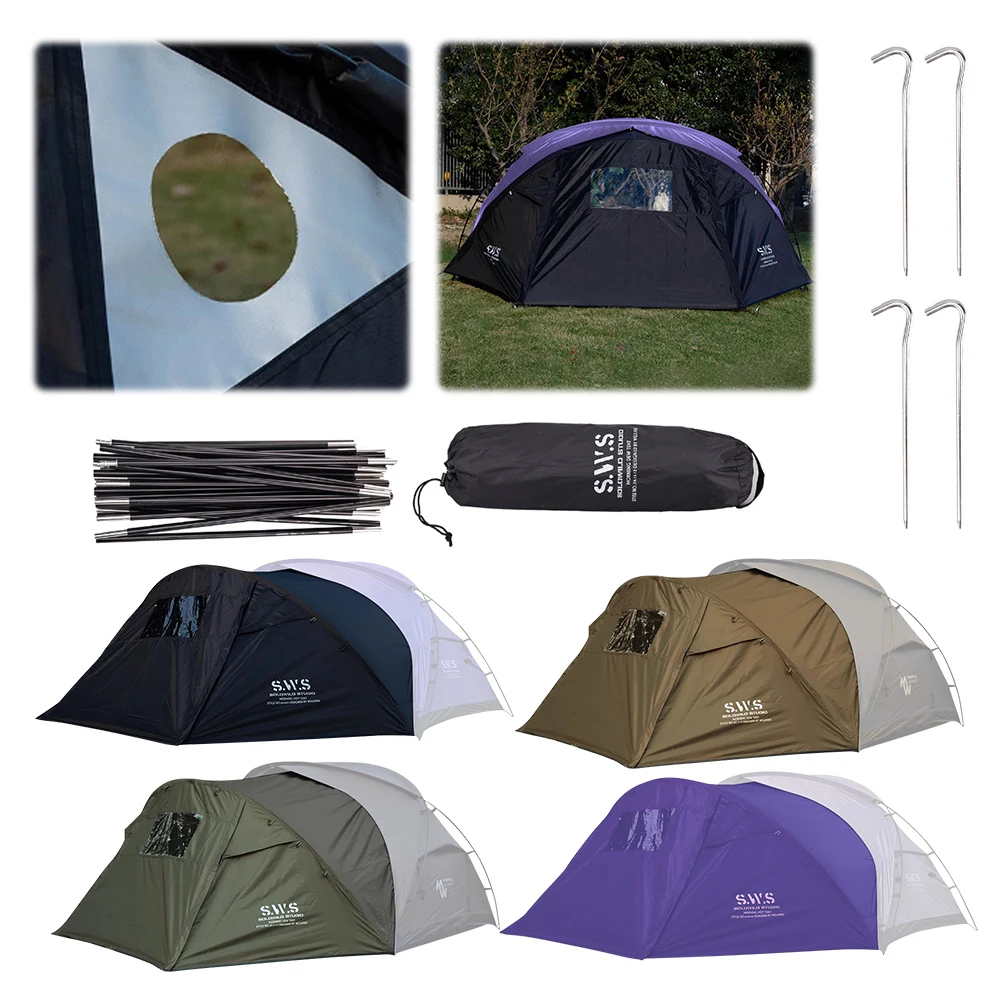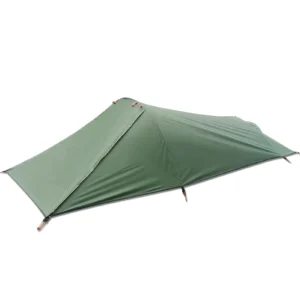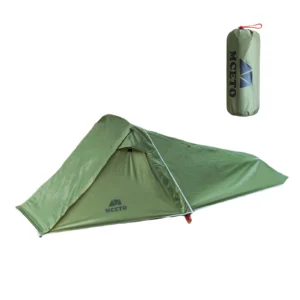Introduction: Why Lightweight Tents Are Essential for Extended Backcountry Adventures
When venturing into the wilderness for multiple days, every ounce in your backpack matters. Lightweight tents have become essential gear for serious trekkers who understand that carrying less weight means more energy for the trail and less fatigue over consecutive hiking days. Finding the perfect balance between weight reduction and maintaining adequate protection is crucial for enjoying your adventure rather than merely enduring it.
In the world of backpacking, “lightweight” typically refers to tents weighing less than 4 pounds (1.8 kg) for a 2-person shelter. The impact of carrying excessive weight can be substantial—experts suggest that each pound on your back equates to an additional 5 miles of perceived hiking distance over a multi-day journey.
Throughout this guide, we’ll explore:
– Top-rated lightweight tent recommendations for various trekking needs
– Critical buying considerations to match your specific requirements
– In-depth reviews of market-leading options
– Practical advice for maintenance and specialized environments
Our recommendations come from rigorous testing across varied terrains and weather conditions, ensuring you can trust the performance of each suggested shelter when you’re miles from civilization. The ultimate guide to lightweight tents for long treks provides additional context for serious backpackers seeking specialized information about weight reduction strategies while maintaining adequate protection in the backcountry.
Understanding the various lightweight tent benefits for extended hikes will help you appreciate why serious trekkers invest in quality shelters that minimize pack weight without sacrificing essential protection.
Quick Reference: Our Top Lightweight Tent Recommendations for 2023
Before diving into the details, here’s a quick overview of our top lightweight tent selections for different trekking needs:
| Model | Weight (Trail/Packed) | Capacity | Tent Type | Price Range | Packed Size | Season Rating | Standout Feature |
|---|---|---|---|---|---|---|---|
| Big Agnes Copper Spur HV UL2 | 2.7 lbs/3.2 lbs (1.2 kg/1.45 kg) | 2-person | Freestanding | $450-500 | 19.5 × 6 in (50 × 15 cm) | 3-season | Best balance of weight & features |
| Zpacks Duplex | 1.2 lbs/1.8 lbs (0.54 kg/0.82 kg) | 2-person | Non-freestanding | $600-650 | 12 × 5.5 in (30 × 14 cm) | 3-season | Ultralight with surprising space |
| REI Co-op Quarter Dome SL 2 | 2.8 lbs/3.3 lbs (1.27 kg/1.5 kg) | 2-person | Freestanding | $350-400 | 18 × 6 in (46 × 15 cm) | 3-season | Excellent value for quality |
| Hilleberg Niak | 3.0 lbs/3.3 lbs (1.36 kg/1.5 kg) | 2-person | Freestanding | $750-800 | 19 × 6 in (48 × 15 cm) | 3+ season | Superior weather resistance |
| MSR Hubba Hubba NX | 3.8 lbs/4.0 lbs (1.72 kg/1.81 kg) | 2-person | Freestanding | $450-500 | 18 × 6 in (46 × 15 cm) | 3-season | Exceptional livable space |
Many experienced hikers on demanding routes incorporate ultralight trekking tents designed for long-distance hikers into their gear strategy, recognizing that shelter weight is one of the “big three” items affecting overall pack weight.
For those ready to explore specific options, our collection of ultralight backpacking tents features models that emphasize minimal weight while maintaining practical functionality for extended trips.
Understanding Weight Categories: What Makes a Tent Truly “Lightweight” for Trekking
Before selecting your ideal tent, it’s important to understand the classification system for backpacking shelters. Weight categories help you compare options and set realistic expectations for what you’ll be carrying.
| Category | Weight Per Person | Best For |
|---|---|---|
| Traditional | 3+ lbs (1.4+ kg) | Occasional backpackers, emphasis on comfort |
| Lightweight | 2-3 lbs (0.9-1.4 kg) | Regular backpackers, balanced approach |
| Ultralight | 1-2 lbs (0.45-0.9 kg) | Dedicated trekkers, weight-conscious |
| Hyperlight | Under 1 lb (Under 0.45 kg) | Minimalists, thru-hikers, fair weather |
When evaluating tent specifications, you’ll encounter several different weight measurements:
– Packed weight: The total weight including everything (tent body, rainfly, poles, stakes, stuff sacks)
– Trail weight: Typically includes just the tent body, rainfly and poles (minimum needed for setup)
– Minimum weight: The absolute minimum components needed (sometimes excluding stakes)
For a 5-day trek, carrying a tent that’s just one pound lighter than average (approximately 0.45 kg) reduces your total carrying effort by about 5 miles (8 km) worth of energy expenditure. This becomes even more significant on longer journeys or in challenging terrain.
The specific elements that make a lightweight tent suitable for trekking include not just the overall weight but also considerations like packed size, ease of setup, and durability in field conditions.
For those debating between categories, our detailed ultralight vs. lightweight tents guide explains the trade-offs and helps you determine which approach best matches your trekking style and needs.
Essential Factors to Consider When Choosing a Lightweight Tent for Multi-Day Treks
Selecting the optimal lightweight tent requires evaluating multiple factors that will directly impact your trekking experience. Your ideal tent will depend on the specific nature of your trips, expected weather conditions, and personal preferences regarding comfort versus weight savings.
Key considerations that we’ll explore in depth include:
– Tent architecture and design (freestanding vs. non-freestanding)
– Weather protection capabilities and seasonal ratings
– Material selection and its impact on durability and weight
– Interior space and comfort features
– Setup complexity and efficiency
– Packed size and portability
– Cost-to-performance ratio
These factors don’t exist in isolation—choosing a tent often involves making deliberate trade-offs. For example, selecting superior weather protection typically means accepting additional weight, while ultralight designs might sacrifice some durability or interior space.
Our ultimate guide to choosing tents for multi-day treks provides additional context for making these important decisions based on your specific trekking style and environmental conditions.
For those ready to explore options, our curated collection of lightweight backpacking tents features models that balance weight savings with practical functionality for extended backcountry travel.
Tent Architecture: Finding the Right Design for Your Trek Style
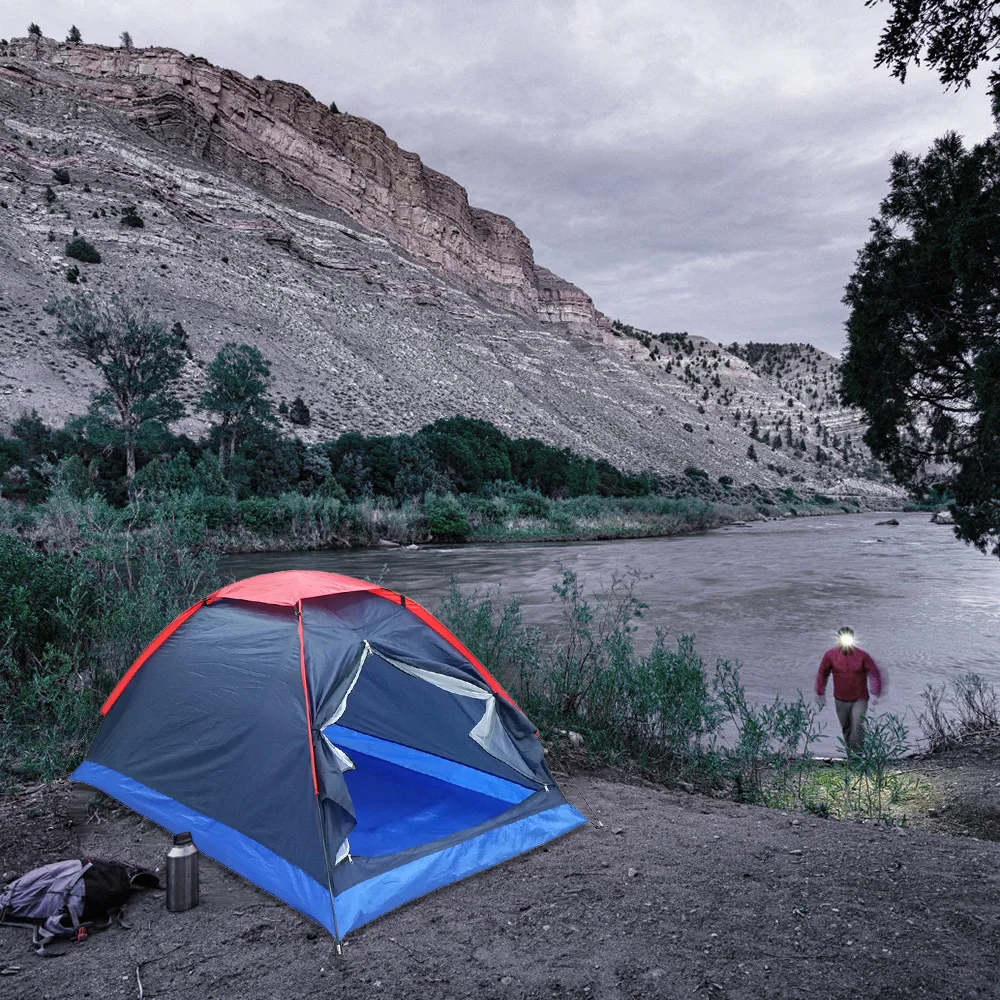
Tent design significantly impacts both performance and carrying weight. Understanding different architectural approaches helps you select a shelter that matches your specific trekking needs.
Freestanding vs. Non-Freestanding Designs:
– Freestanding tents use pole structures that allow the tent to stand without stakes. They offer versatility on various surfaces (rock, sand, platforms) and easier repositioning after setup.
– Pros: Easier setup, more versatile for difficult terrain, more structural stability
– Cons: Usually heavier due to comprehensive pole systems
- Semi-freestanding tents utilize a hybrid approach, using poles for most structural support but requiring some staking for full setup.
- Pros: Weight savings over fully freestanding designs, good stability
Cons: Limited pitching locations compared to freestanding models
Non-freestanding tents (including tarp tents) require staking and often trekking poles for structure.
- Pros: Significant weight savings, often 30-50% lighter than freestanding equivalents
- Cons: Require suitable ground for stakes, more challenging setup, less interior volume
Wall Construction:
– Single-wall tents use one layer of waterproof-breathable fabric.
– Pros: Lighter weight, quicker setup, less packed bulk
– Cons: More condensation issues, often less durable
- Double-wall tents feature separate inner tent (typically mesh) and waterproof rain fly.
- Pros: Better ventilation, less condensation, versatile setup options
- Cons: Heavier, more complex setup, larger packed size
Support Structure:
– Traditional pole tents use dedicated aluminum or carbon fiber poles.
– Pros: Quick, intuitive setup; standalone structure
– Cons: Added weight from carrying dedicated poles
- Trekking pole shelters utilize your hiking poles for structural support.
- Pros: Significant weight savings by using gear you’re already carrying
- Cons: More complex setup, potential stability issues in high winds
The architectural approach that works best depends largely on your trekking style. Fast-and-light alpinists and thru-hikers often prefer non-freestanding trekking pole shelters for maximum weight savings, while weekend backpackers might prefer the convenience and livability of freestanding designs.
For specialized needs, our selection of trekking pole backpacking tents offers ultralight options that leverage equipment you’re already carrying to create shelter while minimizing pack weight.
Weather Protection: Balancing Seasonality and Protection with Weight
When you’re miles from shelter, your tent becomes your most critical protection against the elements. Understanding weather protection features helps you select a tent that provides security without unnecessary weight.
Seasonality Ratings Explained:
– 3-season tents (spring, summer, fall) balance ventilation and weather protection. They handle rain and light snow but aren’t designed for sustained harsh conditions.
– 3+ season tents (extended season) offer additional strength for shoulder seasons, handling moderate snow and stronger winds.
– 4-season tents (all-season/mountaineering) prioritize strength and protection over ventilation, capable of withstanding winter storms but often heavier.
Waterproofing Considerations:
– Hydrostatic head ratings measure water resistance (e.g., 1200mm vs. 3000mm) with higher numbers indicating better waterproofing.
– Seam construction affects water resistance—look for taped, sealed, or welded seams.
– Bathtub floors with raised edges prevent ground water seepage.
– Rainfly coverage should extend to ground level for maximum protection.
Wind Resistance Features:
– Pole structure (number of crossing points, diameter, and material) directly impacts stability.
– Guy-out points allow secure anchoring in high winds—more is generally better.
– Low-profile designs with aerodynamic shapes shed wind more effectively.
– Vestibule positioning relative to prevailing winds affects interior dryness.
Condensation Management:
– Ventilation options like roof vents, adjustable vestibules, and dual doors reduce moisture buildup.
– Fabric breathability varies significantly between materials and affects interior comfort.
– Interior-to-exterior separation in double-wall designs minimizes contact with condensation.
For treks with potential weather exposure, investigate our line of waterproof backpacking tents specifically engineered to maintain dryness in challenging conditions.
When preparing for variable conditions, understanding the complete array of weatherproof gear for multi-day backpacking trips helps create a comprehensive system that works together to keep you safe and comfortable regardless of conditions.
Materials Matter: Understanding Fabric Options and Their Performance
The fabrics used in tent construction dramatically influence weight, durability, packed size, and cost. Understanding these materials helps you make informed trade-offs based on your priorities.
Premium Ultralight Fabrics:
- Dyneema Composite Fabric (DCF) – Formerly called Cuben Fiber
- Weight impact: Extremely light (often 30-50% lighter than nylon equivalents)
- Waterproofing: Inherently waterproof without coatings, doesn’t absorb water or stretch when wet
- Durability: Extremely high tear strength but poor abrasion resistance
- Cost factor: Very expensive (often 2-3x the price of comparable silnylon tents)
Performance notes: Zero stretch when wet, excellent for wet climates
Silnylon (Silicone-impregnated nylon)
- Weight impact: Good weight-to-strength ratio
- Waterproofing: Excellent when new, requires occasional retreatment
- Durability: Good balance of tear and abrasion resistance
- Cost factor: Moderate premium over standard nylon
Performance notes: Stretches when wet, requiring re-tensioning
Silpoly (Silicone-impregnated polyester)
- Weight impact: Slightly heavier than silnylon
- Waterproofing: Excellent and more consistent than silnylon
- Durability: Better UV resistance than nylon, less stretch when wet
- Cost factor: Moderate, similar to silnylon
Performance notes: Minimal stretching when wet, maintains taut pitch
Standard PU-Coated Fabrics
- Weight impact: Typically heavier than silicone-treated fabrics
- Waterproofing: Good initially but degrades over time
- Durability: Reasonable with proper care, but coating can deteriorate
- Cost factor: Most economical option
- Performance notes: PU coatings can break down over time, especially in humid storage
Denier Ratings and Their Meaning:
Denier measures the thickness of individual threads in the fabric—lower numbers indicate thinner threads and lighter fabrics:
– 7-10D: Ultralight but requires careful handling
– 15-20D: Good balance for lightweight trekking
– 30-40D: Standard durability for regular use
– 50-70D: Heavy-duty for floor materials or rough conditions
For a comprehensive understanding of various materials’ performance characteristics, our guide to lightweight trekking shelter materials provides in-depth analysis of how different fabrics perform in various environmental conditions.
Livability Factors: Maximizing Comfort Within Weight Constraints
A tent’s livability—how comfortable it is to occupy during non-sleeping hours—becomes increasingly important on longer treks, especially during weather delays or rest days. Smart design features can significantly enhance comfort without major weight penalties.
Beyond Floor Dimensions:
– Peak height determines whether you can sit up or even stand in certain areas
– Wall slope affects usable space—steeper walls create more usable volume
– Floor shape influences sleeping arrangements and gear organization
– Interior width at shoulder and foot areas affects comfort for two occupants
Vestibule Considerations:
– Size and configuration determine dry storage capacity for packs and boots
– Door access when gear is stored impacts convenience
– Cooking potential in poor weather (with proper ventilation)
– Dual vestibules provide personal space and entry/exit options for each occupant
Interior Organization:
– Mesh pockets keep essentials accessible
– Gear lofts utilize overhead space for additional storage
– Hang loops for lights or clothing
– Doors and entry design affect ease of entry/exit and ventilation options
Shared Space Efficiency:
– Interior volume per person often matters more than simple square footage
– Sleeping pad arrangement options affect comfort for two people
– Private space division possibilities for longer-term comfort
For trekkers who value vestibule space for gear storage and protected cooking areas, our selection of backpacking tents with vestibules offers designs that maximize this critical feature while maintaining reasonable weight profiles.
Setup Efficiency: The Importance of Intuitive Design for Trail-Weary Hikers
After a long day on the trail—particularly in challenging weather—your tent’s setup complexity becomes surprisingly important. Intuitive designs that can be quickly erected by tired hikers have practical advantages beyond mere convenience.
Why Setup Speed Matters:
– Rapidly changing weather conditions demand quick shelter access
– Physical and mental fatigue at day’s end affects coordination
– Earlier camp completion means more rest time
– Cold or wet conditions make extended setup time uncomfortable or dangerous
Design Features That Enhance Setup Efficiency:
– Color-coded poles and connection points eliminate guesswork
– Clip attachments are faster than pole sleeves
– Single-hub pole structures simplify organization
– Pre-attached guy lines save time in windy conditions
– Intuitive rainfly orientation prevents frustrating trial-and-error
Solo Setup Considerations:
– Freestanding designs typically offer easier single-person setup
– Weight distribution across components affects handling
– Partial setup options for quick shelter in emergencies
Efficient Morning Breakdown:
– Quick-release buckles and clips reduce packing time
– Separated storage bags for wet fly/dry inner tent
– Efficient folding techniques for poles and fabrics
For detailed guidance on efficient field techniques, our tutorial on mastering two-person lightweight tent setup provides step-by-step instructions to streamline your camp establishment process regardless of conditions or fatigue level.
In-Depth Reviews: Leading Lightweight Tents for Multi-Day Trekking
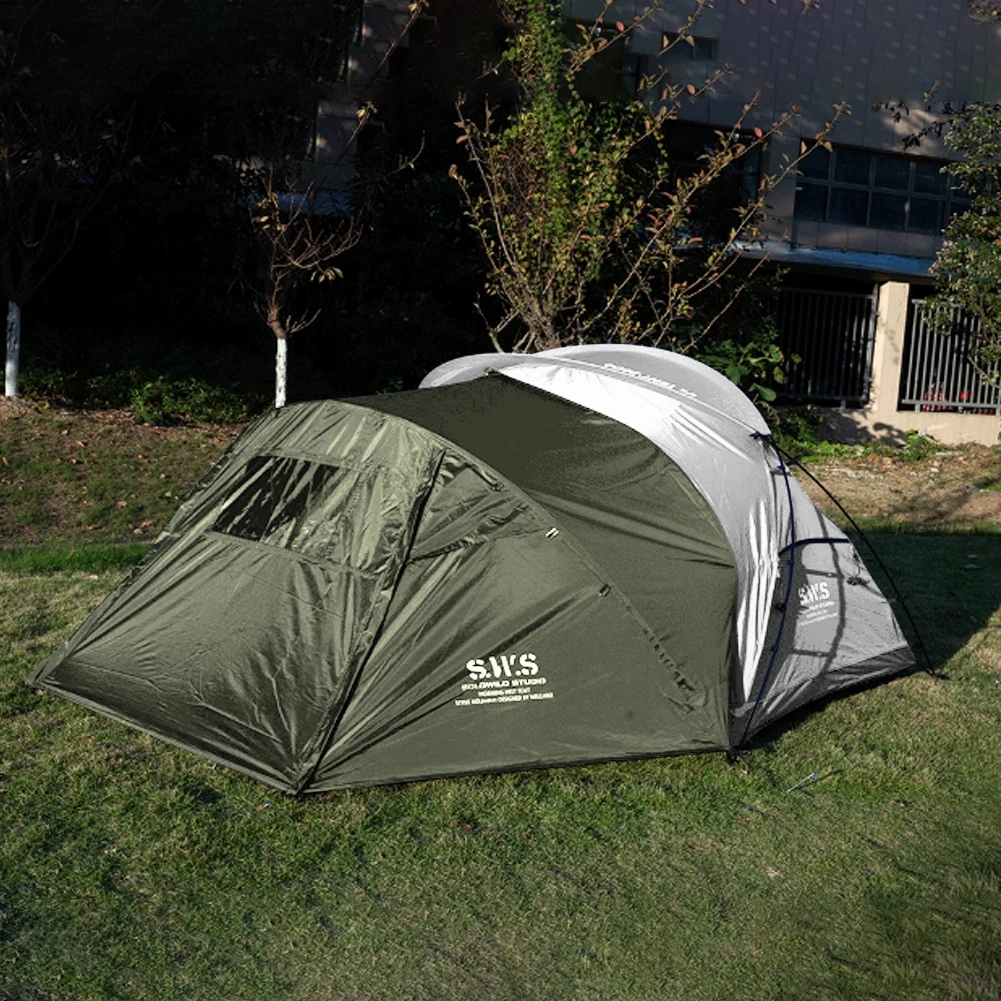
The following reviews represent the standout performers from extensive field testing across varied environments. Each tent was evaluated based on multiple criteria including weather performance, livability, durability, weight, and setup efficiency.
Our testing involved trips ranging from weekend excursions to extended backcountry journeys, allowing assessment under realistic field conditions. Performance was measured across multiple metrics using consistent evaluation standards to ensure reliable comparisons.
These models represent the current market leaders that offer exceptional performance for specific trekking scenarios. While we highlight each tent’s strengths, we also identify limitations to help you match features to your specific needs.
For a deeper understanding of what makes these shelters stand out, our guide to essential features of trekking tents explains the technical elements that distinguish high-performance designs from basic backpacking tents.
Best Overall Lightweight Tent: Big Agnes Copper Spur HV UL2
Specifications:
– Trail Weight: 2.7 lbs (1.2 kg)
– Packed Weight: 3.2 lbs (1.45 kg)
– Floor Dimensions: 88 × 52/42 in (tapered) (224 × 132/107 cm)
– Peak Height: 40 in (102 cm)
– Packed Size: 19.5 × 6 in (50 × 15 cm)
– Floor Material: 15D nylon ripstop
– Fly Material: 15D nylon ripstop
– Poles: Aluminum DAC Featherlite
– Price Range: $450-500
Why It’s Our Top Pick:
The Copper Spur achieves an exceptional balance of weight savings and livability. Its freestanding design features steep walls that maximize interior volume, while the dual-vestibule layout provides ample gear storage without adding significant weight.
Weather Performance:
The full-coverage rainfly extends nearly to ground level, providing excellent protection in driving rain. The pole structure creates a sturdy, stable platform that withstood 30+ mph (48+ km/h) winds during testing without significant deformation.
Standout Features:
– Pre-bent poles create nearly vertical walls for maximum interior space
– Double doors and vestibules provide excellent access and storage
– Color-coded attachment points simplify setup
– Excellent ventilation system minimizes condensation
– Innovative vestibules convert to awnings with trekking poles
Limitations:
– Premium price point
– Relatively thin floor material requires careful site selection
– Not suitable for winter conditions or heavy snow loads
For more detailed analysis of this and other top models, our top lightweight tents expert reviews provide comprehensive evaluation across multiple performance categories.
Best Ultralight Option: Zpacks Duplex
Specifications:
– Trail Weight: 1.2 lbs (0.54 kg)
– Packed Weight: 1.8 lbs (0.82 kg) with stakes and stuff sack
– Floor Dimensions: 90 × 45 in (229 × 114 cm)
– Peak Height: 48 in (122 cm)
– Packed Size: 12 × 5.5 in (30 × 14 cm)
– Materials: Dyneema Composite Fabric (DCF)
– Support: Non-freestanding (requires trekking poles)
– Price Range: $600-650
Why It’s Our Ultralight Pick:
The Duplex represents the pinnacle of ultralight design while maintaining surprising livability. Using premium Dyneema Composite Fabric and a trekking-pole support structure, it achieves a trail weight that’s less than half of many comparable two-person shelters.
Weather Performance:
Despite its minimal weight, the Duplex provides excellent storm protection. The DCF material doesn’t stretch when wet, maintaining a taut pitch throughout rainstorms. The bathtub floor and adjustable vestibules create a weather-tight seal against wind-driven precipitation.
Standout Features:
– Incredibly light trail weight with adequate space for two
– Dual doors and vestibules for convenient access and gear storage
– No-stretch Dyneema material stays taut when wet
– Near-instant drying after rain
– Excellent headroom at the center peak
Limitations:
– Requires trekking poles and adequate staking conditions
– Premium price point
– Less durable than heavier alternatives
– Condensation management requires attention to ventilation
Explore our complete selection of ultralight trekking pole tents to discover additional models that minimize pack weight by leveraging trekking poles for structural support.
Best Budget-Friendly Lightweight Tent: REI Co-op Quarter Dome SL 2
Specifications:
– Trail Weight: 2.8 lbs (1.27 kg)
– Packed Weight: 3.3 lbs (1.5 kg)
– Floor Dimensions: 88 × 52 in (223 × 132 cm)
– Peak Height: 38 in (97 cm)
– Packed Size: 18 × 6 in (46 × 15 cm)
– Floor Material: 20D ripstop nylon
– Fly Material: 15D ripstop nylon
– Poles: DAC Featherlite aluminum
– Price Range: $350-400
Why It’s Our Value Pick:
The Quarter Dome SL 2 delivers impressive performance and features at a price point significantly lower than premium alternatives. While not the absolute lightest option, it strikes an excellent balance between weight, durability, and affordability.
Weather Performance:
The full-coverage rainfly and robust pole structure handle moderate to severe weather conditions with confidence. A comprehensive staking and guy-line system improves stability in high winds.
Standout Features:
– Excellent interior volume for the weight
– Color-coded setup system simplifies pitching
– Near-vertical walls maximize usable space
– Dual doors and vestibules for convenience
– Integrated interior storage pockets
Limitations:
– Slightly heavier than premium ultralight options
– Moderate condensation in humid conditions
– Less packable than more expensive models
For backcountry adventurers seeking minimal pack size without compromising essential protection, our collection of compact backpacking tents features models designed to maximize space efficiency in your pack.
Best Weather-Resistant Lightweight Tent: Hilleberg Niak
Specifications:
– Trail Weight: 3.0 lbs (1.36 kg)
– Packed Weight: 3.3 lbs (1.5 kg)
– Floor Dimensions: 86 × 43 in (218 × 110 cm)
– Peak Height: 36 in (91 cm)
– Packed Size: 19 × 6 in (48 × 15 cm)
– Floor Material: 50D ripstop nylon
– Fly Material: 20D Kerlon 1000 silnylon
– Poles: 9mm DAC aluminum
– Price Range: $750-800
Why It’s Our Weather Champion:
The Hilleberg Niak exemplifies the Swedish company’s reputation for building shelters that withstand extreme conditions while maintaining reasonable weight. Its tunnel design and integrated pitch (fly and inner tent together) create a storm-worthy shelter that sets up quickly in adverse weather.
Weather Performance:
Tested in sustained 40+ mph (64+ km/h) winds and driving rain, the Niak remained rock-solid when properly guyed out. The silicone-coated Kerlon fabric offers exceptional tear strength, while the integrated design prevents inner tent exposure during setup in rainy conditions.
Standout Features:
– Exceptional stability in high winds
– True three-season+ performance (handles light snow loads)
– Unified setup keeps inner tent dry during rainy installation
– Higher hydrostatic head ratings than most lightweight tents
– Extremely durable materials compared to typical lightweight shelters
Limitations:
– Premium price point
– Single entrance and vestibule
– Heavier than ultralight alternatives
– Requires proper tensioning for optimal performance
For trekkers who prioritize structural stability and ease of setup, our selection of freestanding backpacking tents offers designs that provide reliable shelter without requiring perfect staking conditions.
Most Spacious Lightweight Tent: MSR Hubba Hubba NX

Specifications:
– Trail Weight: 3.8 lbs (1.72 kg)
– Packed Weight: 4.0 lbs (1.81 kg)
– Floor Dimensions: 84 × 50 in (213 × 127 cm)
– Peak Height: 39 in (99 cm)
– Packed Size: 18 × 6 in (46 × 15 cm)
– Floor Material: 30D ripstop nylon
– Fly Material: 20D ripstop nylon
– Poles: Easton Syclone composite
– Price Range: $450-500
Why It’s Our Spacious Pick:
The Hubba Hubba NX creates an exceptional living space through intelligent design that maximizes usable volume. While slightly heavier than ultralight options, it compensates with significant comfort advantages for longer trips or extended weather delays.
Weather Performance:
The symmetrical pole structure creates excellent stability in varied conditions. The rainfly extends nearly to ground level, while still maintaining ventilation through adjustable vestibule configurations.
Standout Features:
– Near-vertical walls create maximum usable interior volume
– Generous 39-inch (99 cm) peak height throughout much of the tent
– Oversized vestibules provide excellent gear storage
– Durable materials withstand extended use
– Composite poles resist breaking under stress
Limitations:
– Heavier than minimalist alternatives
– Premium price point
– Larger packed size than ultralight options
When considering weight trade-offs for additional space and features, many backpackers wonder is a 3kg backpacking tent too heavy for their specific trekking style and conditions.
Lightweight Backpacking Tent, Ultralight Backpacking Tent, Ultralight Bivy Tent
Ultralight Single Person Camping Tent with Aluminum Poles for 3-Season Backpacking Waterproof DesignPrice range: $94.88 through $326.82 Select options This product has multiple variants. The options may be chosen on the product pageLightweight Backpacking Tent, Ultralight Backpacking Tent, Waterproof Backpacking Tent
$391.05 Select options This product has multiple variants. The options may be chosen on the product pageCompact Backpacking Tent, Lightweight Backpacking Tent, Waterproof Camping Tent
$335.52 Select options This product has multiple variants. The options may be chosen on the product pageUltralight Backpacking Tent, Ultralight Dome Tent, Winter Camping Tent
Price range: $369.63 through $370.07 Select options This product has multiple variants. The options may be chosen on the product pageBackpacking Tent with Vestibule, Freestanding Backpacking Tent, Lightweight Backpacking Tent
Price range: $446.89 through $447.22 Select options This product has multiple variants. The options may be chosen on the product pageBackpacking Tent with Vestibule, Trekking Pole Backpacking Tent, Waterproof Camping Tent
Price range: $271.99 through $519.52 Select options This product has multiple variants. The options may be chosen on the product page
Essential Maintenance for Extended Trek Durability
Lightweight tents often utilize more delicate materials than their heavier counterparts, making proper maintenance crucial for longevity. Following these practices will extend your tent’s life span and maintain its performance during extended treks.
Field Care During Multi-Day Trips:
– Choose campsites carefully—avoid sharp objects and abrasive surfaces
– Use a footprint or groundsheet under thin floor materials
– Clean debris from zippers daily to prevent mechanism damage
– Dry condensation from inner walls when possible
– Tension guy lines and adjust stakes as ground softens or hardens
Campsite Selection Strategies:
– Seek natural wind protection while maintaining some airflow
– Avoid low areas where water might collect during rain
– Consider sun exposure for drying morning condensation
– Look for level ground to prevent sliding during sleep
Extended Trip Maintenance:
– Air dry tent completely when opportunity allows
– Periodically clean stuck dirt from zippers with water
– Re-waterproof seams if leaking develops
– Inspect and repair small tears immediately before they expand
Post-Trip Care:
– Thoroughly clean with non-detergent soap if necessary
– Ensure complete drying before storage
– Store loosely in dry, cool location (not compressed)
– Repair any damage promptly before next use
Essential Repair Kit Items:
– Tenacious Tape or similar repair tape
– Seam sealer
– Spare guy line
– Replacement stakes
– Pole repair sleeve
Understanding the specific features and requirements of ultralight tents designed for thru-hiking helps you maintain your shelter appropriately for the challenges of long-distance travel.
Frequently Asked Questions About Lightweight Trekking Tents
What weight is considered ‘lightweight’ for a backpacking tent?
In 2023, a two-person tent under 4 pounds (1.8 kg) is generally considered lightweight, with ultralight options under 2.5 pounds (1.1 kg). Single-person tents should target under 3 pounds (1.4 kg) for lightweight classification and under 1.5 pounds (0.7 kg) for ultralight.
Are ultralight tents durable enough for extended trips?
Most premium ultralight tents can handle extended trips with proper care. The key is appropriate site selection and careful handling. Many thru-hikers successfully use ultralight shelters for 2000+ mile (3200+ km) journeys, though they may accept more frequent replacement cycles than with heavier options.
How do I minimize condensation in a lightweight tent?
Strategic ventilation is critical—use all available vents, leave vestibule doors partially open when possible, and position the tent to catch prevailing breezes. Site selection also matters; avoid camping near water sources when possible and pitch your tent under trees rather than in open meadows to reduce dew formation.
Can I use my trekking poles with any non-freestanding tent?
Not universally. Trekking pole tents are designed for specific pole heights and handle configurations. Check compatibility carefully, as some require adjustable poles of particular lengths or specific tip adaptors. Most accommodate standard trekking poles, but adjustability is often necessary for proper pitching.
Are footprints necessary for lightweight tents?
While not absolutely required, footprints significantly extend the life of lightweight tent floors, which often use thinner materials (15-20D) than traditional tents. For extended trips where reliability is critical, the small weight penalty of a footprint (2-4 oz/57-113 g) provides valuable protection against punctures and abrasion.
How do I pack a wet tent without damaging it?
When breaking camp with a wet tent, separate the rainfly from the inner tent if possible and pack them in different waterproof stuff sacks. If separation isn’t possible, loosely pack the tent and plan to air it out during a lunch break. Never store a wet tent for more than 24 hours to prevent mildew growth and fabric degradation.
Understanding how heavy a hiking tent should be for your specific adventure type helps set appropriate expectations and guides purchasing decisions for different trip durations and conditions.
How We Selected and Tested These Tents
Our recommendations come from comprehensive real-world testing across diverse environments and conditions. Each tent underwent evaluation in multiple locations including alpine environments, desert terrain, and forest settings to assess performance across varied conditions.
Testing criteria included:
– Weather resistance (rain, wind, and temperature management)
– Ease of setup and breakdown (timed trials, both dry and wet conditions)
– Interior comfort and livability (usable space measurements)
– Durability and construction quality
– Packability and carrying convenience
– Ventilation and condensation management
– Overall value relative to price
Each tent was tested during actual backpacking trips ranging from weekend excursions to extended journeys, allowing assessment of comfort over multiple consecutive nights. Additional stress testing included pitched exposure during significant weather events to evaluate storm worthiness.
Our testing team includes experienced backpackers with thousands of collective trail miles, providing perspective on long-term performance expectations and practical usability features that matter during extended treks.
Understanding why tent weight matters on long treks was fundamental to our evaluation process, guiding how we balanced various performance factors against weight considerations.
Specialized Considerations: Tent Selection for Specific Trek Types
Different trekking environments create unique shelter requirements. Adapting your tent selection to specific conditions enhances both comfort and safety.
High-Altitude Alpine Routes:
– Prioritize wind stability with low-profile designs
– Look for extra guy points and robust pole structures
– Consider a shelter rated for more severe conditions than expected
– Ensure adequate ventilation to manage significant temperature fluctuations
Desert Treks:
– Seek maximum ventilation options
– Consider lighter-colored rainflies to reflect heat
– Look for freestanding designs for sand/rock setup
– UV-resistant materials become more important
Humid Forest Environments:
– Prioritize superior ventilation to combat condensation
– Ensure full bug protection with complete mesh inners
– Consider larger vestibules for wet gear management
– Look for quick-drying fabrics and effective drainage features
Thru-Hiking Long Trails:
– Focus on absolute weight minimization
– Durability becomes crucial for 2000+ mile journeys
– Consider models with available replacement parts
– Prioritize fast-drying materials
Winter or Shoulder Season Adventures:
– Look for stronger pole structures to handle snow loads
– Steeper wall designs shed snow more effectively
– Consider vestibule space for gear and potential cooking
– Reduced ventilation mesh minimizes heat loss
For specialized environments like winter mountaineering, our guide to compact winter tents for alpine hiking provides specific recommendations for shelters designed to handle extreme conditions while maintaining reasonable weight profiles.
When selecting your lightweight tent for multi-day treks, carefully consider your specific environmental needs and trekking style. The perfect tent balances weight savings with the protection and features required for your unique adventures, enhancing both safety and enjoyment during your wilderness experiences. At Explore Elements, we’re dedicated to helping you find that perfect balance for your next backcountry journey.

